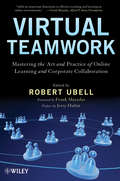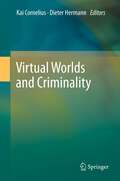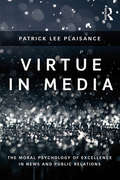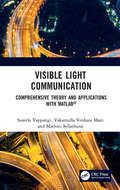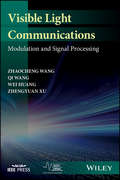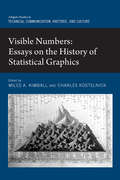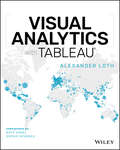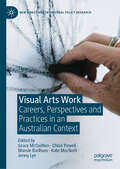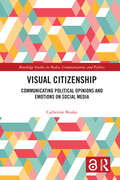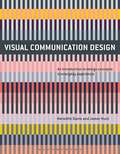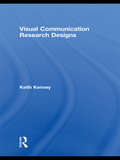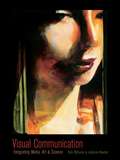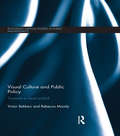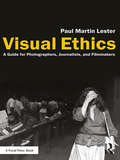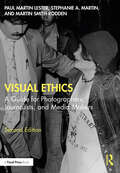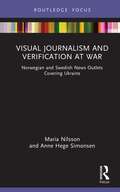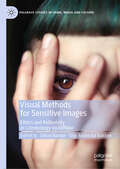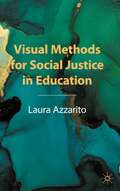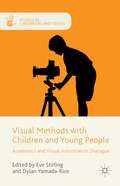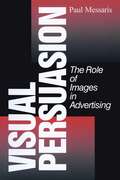- Table View
- List View
Virtual Teamwork: Mastering the Art and Practice of Online Learning and Corporate Collaboration
by Jerry Hultin"This book, by Robert Ubell and his excellent team of collaborators, adds an important dimension to effective teaching and learning in online environments. It addresses how interaction and collaboration online can be effectively harnessed in virtual teams. It is an important contribution to the larger field of Internet-based education." —Frank Mayadas, Alfred P. Sloan Foundation How to create and manage highly successful teams online With the advent of the global economy and high-speed Internet, online collaboration is fast becoming the norm in education and industry. This book takes online collaboration to the next level, showing how you can bolster online learning and business performance with the innovative use of virtual teams. Written by a team of experts headed by online learning pioneer Robert Ubell, Virtual Teamwork covers best practices for online instruction and team learning, reveals proven techniques for managing enterprise and global virtual teams, and helps you choose the best communication tools for the job. Educators, project managers, and anyone involved in teaching online courses or creating online programs will find a wealth of tips and techniques for building and managing successful virtual teams, including guidance for: Integrating team instruction in the virtual classroom Using best techniques for team interaction across borders and time zones Structuring cost-effective, competitive projects that work Leveraging leadership, mentoring, and conflict management in virtual teams Conducting testing, grading, and peer- and self-assessment online Managing corporate, global, and engineering virtual teams Choosing the right technologies for effective collaboration
Virtual Worlds and Criminality
by Dieter Hermann Kai Cornelius, LL.M.The fusion between virtuality and reality has created a new quality of experience establishing metaverses and virtual worlds. Second Life, Twinity, Entropia Universe or Fregger have experienced rapid growth in recent years and show no signs of slowing down. Not only have countless companies discovered these "virtureal worlds" as marketplaces, but so have fraudsters and other criminals. In this book, European experts from different academic disciplines show how to meet the new challenges arising from virtual worlds. They discuss the reasons for and the impacts of these new forms of criminality as well as the necessity and means of combating them. Moreover, other fundamental issues are examined, such as the addictive potential of virtual-world use, media violence, and conflict resolution problems arising in the context of virtual worlds.
Virtualization of Universities
by Thomas PfefferThe purpose of this volume is to shape conceptual tools to understand the impact of new information and communication technologies (ICTs) on the organization of universities. Traditional research-based universities, the most typical representatives of the higher education system, find themselves challenged by the speed and the wide range of technical innovations, but also by a vast array of implicit assumptions and explicit promises associated with the distribution of digital media. The author observes that as universities increasingly use digital media (computers and the Internet) to accomplish their tasks, a transformation takes place in an evolutionary rather than in a revolutionary way. Using the University of Klagenfurt as an in-depth case study, he explores such dynamic issues as how digital media affect the practice of research, the preservation and dissemination of knowledge (for example, through publishing and archiving), and delivery of education at universities. More broadly, he considers issues of organizational culture and design, administration, and leadership as universities integrate digital technologies into all aspects of their operations.
Virtue Ethics and Professional Journalism
by Aaron QuinnThis book examines the moral role of news media practitioners and organizations, and applies a modified philosophical account of Virtue Ethics as a framework for the role of journalists—and journalism organizations—in public life. It shows how journalists and news organizations that adopt an aim towards professional excellence (virtue) by putting a premium on investigative journalism—with both large and small measures depending on the nature of the reporting—can achieve lofty professional goals under modern deadlines. The news media, both electronic and traditional, are imperative to an informed public, and an informed public is critical to a properly functioning cross-section of social, government and corporate domains. The book emphasizes the virtues of justice and integrity as foundational to professional practice. It examines the modern ethical challenges presented by organizations ranging from online upstarts to massive media conglomerates, each that have economic challenges that can inhibit professional excellence through corruption or corrosion. The author applies his account of virtue—bolstered by suggestions for complementary reforms in education and regulation—to improve an ethically challenged industry as it undergoes significant technological change.
Virtue in Media: The Moral Psychology of Excellence in News and Public Relations
by Patrick Lee PlaisanceThis work establishes a contemporary profile of virtue in professional media practice. Author Patrick Lee Plaisance examines the experiences, perspectives, moral stances, and demographic data of two dozen professional exemplars in journalism and public relations. Plaisance conducted extensive personal "life story" interviews and collected survey data to assess the exemplars’ personality traits, ethical ideologies, moral reasoning skills and perceived workplace climate. The chosen professionals span the geographic United States, and include Pulitzer Prize winners and trendsetting PR corporate executives, ranging from rising stars to established veterans. Their thoughts, opinions, and experiences provide readers with an insider’s perspective on the thought process of decision makers in media. The unique observations in this volume will be stimulating reading for practitioners, researchers, and students in journalism and public relations. Virtue in Media establishes a key benchmark, and sets an agenda for future research into the moral psychology of media professionals.
Visible Light Communication
by Shlomi ArnonVisible light communication (VLC) is an evolving communication technology for short-range applications. Exploiting recent advances in the development of high-power visible-light emitting LEDs, VLC offers an energy-efficient, clean alternative to RF technology, enabling the development of optical wireless communication systems that make use of existing lighting infrastructure. Drawing on the expertise of leading researchers from across the world, this concise book sets out the theoretical principles of VLC, and outlines key applications of this cutting-edge technology. Providing insight into modulation techniques, positioning and communication, synchronisation, and industry standards, as well as techniques for improving network performance, this is an invaluable resource for graduate students and researchers in the fields of visible light communication, optical wireless communication, and industrial practitioners in the field of telecommunications.
Visible Light Communication: Comprehensive Theory and Applications with MATLAB®
by Mathini Sellathurai Suseela Vappangi Vakamulla Venkata ManiThe field of visible light communication (VLC) has diverse applications to the end user including streaming audio, video, high-speed data browsing, voice over internet and online gaming. This comprehensive textbook discusses fundamental aspects, research activities and modulation techniques in the field of VLC. Visible Light Communication: A Comprehensive Theory and Applications with MATLAB® discusses topics including line of sight (LOS) propagation model, non-line of sight (NLOS) propagation model, carrier less amplitude and phase modulation, multiple-input-multiple-output (MIMO), non-linearities of optical sources, orthogonal frequency-division multiple access, non-orthogonal multiple access and single-carrier frequency-division multiple access in depth. Primarily written for senior undergraduate and graduate students in the field of electronics and communication engineering for courses on optical wireless communication and VLC, this book: Provides up-to-date literature in the field of VLC Presents MATLAB codes and simulations to help readers understand simulations Discusses applications of VLC in enabling vehicle to vehicle (V2V) communication Covers topics including radio frequency (RF) based wireless communications and VLC Presents modulation formats along with the derivations of probability of error expressions pertaining to different variants of optical OFDM
Visible Light Communications: Modulation and Signal Processing (IEEE Series on Digital & Mobile Communication)
by Zhaocheng Wang Wei Huang Qi Wang Zhengyuan XuA complete and comprehensive reference on modulation and signal processing for visible light communication This informative new book on state-of-the-art visible light communication (VLC) provides, for the first time, a systematical and advanced treatment of modulation and signal processing for VLC. Visible Light Communications: Modulation and Signal Processing offers a practical guide to designing VLC, linking academic research with commercial applications. In recent years, VLC has attracted attention from academia and industry since it has many advantages over the traditional radio frequency, including wide unregulated bandwidth, high security, and low cost. It is a promising complementary technique in 5G and beyond wireless communications, especially in indoor applications. However, lighting constraints have not been fully considered in the open literature when considering VLC system design, and its importance has been underestimated. That’s why this book—written by a team of experts with both academic research experience and industrial development experience in the field—is so welcome. To help readers understand the theory and design of VLC systems, the book: Details many modern techniques on both modulation and signal processing aspects Links academic research with commercial applications in visible light communications as well as other wireless communication systems Combines theoretical rigor with practical examples in presenting optical camera communication systems Visible Light Communications: Modulation and Signal Processing serves as a useful tool and reference book for visible light communication professionals, as well as wireless communication system professionals and project managers. It is also an important guide for undergraduates and graduates who want to conduct research in areas of wireless communications.
Visible Numbers: Essays on the History of Statistical Graphics
by Charles KostelnickBringing together scholars from around the world, this collection examines many of the historical developments in making data visible through charts, graphs, thematic maps, and now interactive displays. Today, we are used to seeing data portrayed in a dizzying array of graphic forms. Virtually any quantified knowledge, from social and physical science to engineering and medicine, as well as business, government, or personal activity, has been visualized. Yet the methods of making data visible are relatively new innovations, most stemming from eighteenth- and nineteenth-century innovations that arose as a logical response to a growing desire to quantify everything-from science, economics, and industry to population, health, and crime. Innovators such as Playfair, Alexander von Humboldt, Heinrich Berghaus, John Snow, Florence Nightingale, Francis Galton, and Charles Minard began to develop graphical methods to make data and their relations more visible. In the twentieth century, data design became both increasingly specialized within new and existing disciplines-science, engineering, social science, and medicine-and at the same time became further democratized, with new forms that make statistical, business, and government data more accessible to the public. At the close of the twentieth century and the beginning of the twenty-first, an explosion in interactive digital data design has exponentially increased our access to data. The contributors analyze this fascinating history through a variety of critical approaches, including visual rhetoric, visual culture, genre theory, and fully contextualized historical scholarship.
Visions of Infamy: The Untold Story of How Journalist Hector C. Bywater Devised the Plans that Led to Pearl Harbor
by William H. HonanJapanese Admiral Isoroku Yamamoto smashed the American fleet at Pearl Harbor on Dec. 7, 1941, yet the man who first conceived of the Pacific war -- Japan's surprise attack, the seizure of the Philippines and Guam, and the American island-hopping campaign -- was a British naval correspondent, Hector C. Bywater. He wrote a series of brilliant books and articles in the 1920s and 1930s that prophetically outlined naval strategies that would read like a blueprint for the Pacific Theater during World War II. Bywater's ideas created an uproar and then were quickly forgotten. But Yamamoto adopted Bywater's ideas as his own.
Visual Analytics with Tableau
by Alexander LothA four-color journey through a complete Tableau visualization Tableau is a popular data visualization tool that’s easy for individual desktop use as well as enterprise. Used by financial analysts, marketers, statisticians, business and sales leadership, and many other job roles to present data visually for easy understanding, it’s no surprise that Tableau is an essential tool in our data-driven economy. Visual Analytics with Tableau is a complete journey in Tableau visualization for a non-technical business user. You can start from zero, connect your first data, and get right into creating and publishing awesome visualizations and insightful dashboards. • Learn the different types of charts you can create • Use aggregation, calculated fields, and parameters • Create insightful maps • Share interactive dashboards Geared toward beginners looking to get their feet wet with Tableau, this book makes it easy and approachable to get started right away.
Visual Arts Work: Careers, Perspectives and Practices in an Australian Context (New Directions in Cultural Policy Research)
by Marnie Badham Kate MacNeill Grace McQuilten Chloë Powell Jenny LyeThis book provides the most comprehensive picture to date of work in the visual arts ecosystem in Australia. In a context where artists’ incomes are consistently low and falling, commercial galleries are financially vulnerable, and public galleries face program funding challenges — this book explores barriers to the economic health of the sector, the challenge of improving artists’ and arts workers’ working conditions, and the realities of being a creative in the twenty-first century. The book combines an analysis of art world economic value chains alongside alternative and emergent cultural, social and political economies with new quantitative and qualitative insights from artists and arts workers. With interdisciplinary methodologies and industry engagement, it examines multiple and hybrid systems of value and includes the perspectives of visual artists, craft artists and arts workers with diverse lived experiences. Our research offers greater insight into the social, cultural, and political forces that underly the mediation of art to the public including an urgent emphasis on gender, cultural safety and care work including the concerns of First Nations artists, culturally and linguistic diverse artists, and artists with disability. Our approach unpacks the diversity and hybridity of art ‘work’ to include practices realised through digitisation, internationalisation, community engagement and intersectoral partnerships.
Visual Citizenship: Communicating political opinions and emotions on social media (Routledge Studies in Media, Communication, and Politics)
by Catherine BoukoThis book explores visual political engagement online – how citizens participate in the dynamism of life in society by expressing their opinions and emotions on various issues of democratic life in image-based social media posts, independently of collective actions.Looking beyond large digital social movements to focus on the everyday, the book provides a well-documented and comprehensive framework of key notions, concrete methods and examples of empirical insights into everyday visual citizenship on social media. It shows how the visual has become ubiquitous in citizens’ communication on social media, focusing on how citizens use visual content to express their emotions and opinions on social media platforms when they discuss politics in a large sense.With this book, every reader interested in political communication, visual communication and/or new media is fully equipped to analyse everyday visual citizenship on social media platforms.The Open Access version of this book, available at http://www.taylorfrancis.com, has been made available under a Creative Commons [Attribution-Non Commercial-No Derivatives (CC-BY-NC-ND)] 4.0 license.
Visual Communication Design: An Introduction To Design Concepts In Everyday Experience (Required Reading Range #75)
by Meredith Davis Jamer HuntThis book traces the origins of visual phenomena and principles for the arrangement of form by providing examples that encounter in going about the daily lives. The authors provide a new slant on design basics from the perspective of audiences and users. Chapters break down interactions with communication as a sequence of meaningful episodes, each with related visual concepts that shape the interpretive experience. Explanatory illustrations and professional design examples support definitions of visual concepts and discussions of context. Work spans print, screen and environmental applications from around the world.
Visual Communication Research Designs
by Keith KenneyVisual Communication Research Designs provides a step-by-step guide for designing research involving visuals relevant to communications media. This volume explains the process from conceptualization to research questions, instrumentation, analysis, and reliability and validity checks. It also addresses the lack of sufficient methods to answer theoretical questions attending visual communication. This resource has been developed in response to the circumstance in which, in many cases, the methodologies used for verbal and textual communications are inappropriate or ineffective when applied or adapted for the study of visual communications. Additionally, research articles from ethnography, action research, rhetoric, semiotics, psychology, cultural studies, and critical theory often do not use examples appropriate to visual communication readers. To address these issues, this book explains in clear and straightforward language key research designs, including new methodologies, that are appropriate for scholars and students conducting visual communication research. Organized into three parts -- production, analysis, and effects of visuals – this research text provides guidance in using, interpreting and measuring the effects of visual images. It addresses such topics as: producing photographs and video that can be used as research data; interpreting images that already exist; measuring the effects of visuals and to understand their use by different groups. Ethical issues are included, as well as a discussion of the advantages and limitations of each method. "War stories" are provided by experienced researchers, who discuss a particular research project and explain pitfalls to avoid, as well as what to do when problems occur. The primary audiences are scholars, researchers, and students conducting research on motion pictures, video, television, photographs, illustrations, graphics, typography, political cartoons, comic books, animation, and other media with a visual component. Individuals will use this text whenever they need to conduct research that involves visuals in the media. The book will be a required text for advanced courses in visual culture, seminars on visual communication research, and other research methods courses integrating a visual component.
Visual Communication: Integrating Media, Art, and Science
by Rick Williams Julianne NewtonA well-rounded education in the 21st century requires not just verbal and mathematical proficiency, but also the ability to interpret, critique, create, and use visual communication on sophisticated levels. In today’s visual world, it is critically important to hold an appreciation for the profound effects imagery has on individuals and the communities in which they live. Visual Communication focuses on cultivating visual and media literacy from both consumption and production points of view and introduces students to the application of intuitive intelligence to a visual context. Innovative in its field, it provides a solid theoretical overview of the most advanced thinking and research about visual communication, teaching readers how to apply theory to enhance their understanding of and work with images. This book is intended for students in visual literacy and communication courses. It can also be used in photojournalism courses and other coursework with a visual component. Individuals interested in mass media studies will likewise find the book to be a worthwhile read.
Visual Culture and Public Policy: Towards a visual polity? (Routledge Critical Studies in Public Management)
by Victor Bekkers Rebecca MoodyTraditionally, images have played an important role in politics and policy making, mostly in relation to propaganda and public communication. However, contemporary society is inundated with visual material due to the increasing ubiquity of media and visual technologies that facilitate the production, distribution and consumption of images in new and innovative ways. As such, a visual culture has emerged, and a number of authors have written on visual culture and the technologies which underlie it. However, a clear link to policy making is still lacking. This books links the emergence of this visual culture to policy making and explores how visual culture (and the growing number of technologies used to create and distribute images) influence the course, content and outcome of public policy making. It examines how visual culture and policy making in contemporary society are intertwined, elaborating concepts such as power, framing and storytelling. It then links this to technology, and the way this can enhance power, transparency, registration, surveillance and communication. Dealing with the entire cycle of public policy making, from agenda-setting, to policy design, decision making to evaluation, the book contains diverse international case studies including water management, risk management, live-stock diseases, minority integration, racism, freedom of speech, healthcare, disaster evaluation and terrorism.
Visual Ethics: A Guide for Photographers, Journalists, and Filmmakers
by Paul Martin LesterVisual Ethics addresses the need for critical thinking and ethical behavior among professionals responsible for visual messages in photography and photojournalism, film, and digital media. From the author of Photojournalism: An Ethical Approach, published more than 20 years ago, this book goes beyond photojournalism ethics. It discusses crucial contemporary concerns, including persuasion, stereotyping, global perspectives, graphic design decisions, multimedia production, social media, and more. Written for an ever-growing discipline, author Paul Martin Lester gives serious ethical consideration to the complex field of visual communication.
Visual Ethics: A Guide for Photographers, Journalists, and Media Makers
by Paul Martin Lester Stephanie A. Martin Martin Smith-RoddenAn indispensable guide to visual ethics, this book addresses the need for critical thinking and ethical behavior among students and professionals responsible for a variety of mass media visual messages. Written for an ever-growing discipline, authors Paul Martin Lester, Stephanie A. Martin, and Martin Rodden-Smith give serious ethical consideration to the complex field of visual communication. The book covers the definitions and uses of six philosophies, analytical methods, cultural awareness, visual reporting, documentary, citizen journalists, advertising, public relations, typography, graphic design, data visualizations, cartoons, motion pictures, television, computers and the web, augmented and virtual reality, social media, the editing process, and the need for empathy. At the end of each chapter are case studies for further analysis and interviews with thoughtful practitioners in each field of study, including Steven Heller and Nigel Holmes. This second edition has also been fully revised and updated throughout to reflect on the impact of new and emerging technologies. This book is an important resource for students of photojournalism, photography, filmmaking, media and communication, and visual communication, as well as professionals working in these fields.
Visual Ethics: A Guide for Photographers, Journalists, and Media Makers
by Paul Martin Lester Stephanie A. Martin Martin Smith-RoddenAn indispensable guide to visual ethics, this book addresses the need for critical thinking and ethical behavior among students and professionals responsible for a variety of mass media visual messages.Written for an ever-growing discipline, authors Paul Martin Lester, Stephanie A. Martin, and Martin Rodden-Smith give serious ethical consideration to the complex field of visual communication. The book covers the definitions and uses of six philosophies, analytical methods, cultural awareness, visual reporting, documentary, citizen journalists, advertising, public relations, typography, graphic design, data visualizations, cartoons, motion pictures, television, computers and the web, augmented and virtual reality, social media, the editing process, and the need for empathy. At the end of each chapter are case studies for further analysis and interviews with thoughtful practitioners in each field of study, including Steven Heller and Nigel Holmes. This second edition has also been fully revised and updated throughout to reflect on the impact of new and emerging technologies.This book is an important resource for students of photojournalism, photography, filmmaking, media and communication, and visual communication, as well as professionals working in these fields.
Visual Journalism and Verification at War: Norwegian and Swedish News Outlets Covering Ukraine (Disruptions)
by Maria Nilsson Anne Hege SimonsenConsidering the visual coverage of the war in Ukraine, this book provides critical insights into how newsrooms make use of visual materials, how visuals partake in journalistic storytelling in a modern wartime context, and how visual journalism practices affect the news media’s role as arbiter of accuracy and ethics.Based on a mixed-methods study, including analyses of selected visually driven news stories and interviews with media professionals in Norwegian and Swedish national media outlets houses, this book examines the news media’s approach to the visual coverage of the war in Ukraine following Russian invasion in 2022. The work is theoretically underpinned by ongoing boundary work within journalism, and editorial negotiations over issues such as verification, source criticism, and trust; witnessing and ways of seeing; and ethical gatekeeping in photojournalism. At a juncture of rising concerns over AI, public distrust, and propaganda, this study adds a real-time aspect to these debates and reveals challenges as well as emerging strategies in the unfolding coverage. Furthermore, the comparative Scandinavian context serves to highlight points of tension between the global and the local; between those newsrooms relying on global image brokers and those conducting their own in-house reporting.Written for researchers and advanced students of Visual Journalism and Conflict Reporting, this book is a timely intervention.
Visual Methods for Sensitive Images: Ethics and Reflexivity in Criminology On/Offline (Palgrave Studies in Crime, Media and Culture)
by Sidsel Harder Silje Anderdal BakkenThis edited book provides a toolbox for researchers and students working with sensitive images in criminological research on and offline. Across three sections on collecting, analysing and mediating sensitive visual data, the chapters cover a wide array of current examples and discussions of visual methods and ethics in contemporary, digital-life criminology. It reflects the experiences of influential and innovative scholars engaging in empirical analysis of images across various subfields within criminology, including with images that deal with crime, social problems and stigma. They emphasize the opportunity for gaining knowledge through visual analysis and include methodological discussions of how to approach such sensitive data material. Some chapters address visuals as data in mediated realities and the related methodological concerns. The book also contributes to discussing the various ethical sides to researching crime-related sensitive images, such as anonymity, consent, and access, but also relates to researcher reflexivity and protecting researchers' well-being.
Visual Methods for Social Justice in Education
by Laura AzzaritoThis book makes a case for the usefulness of visual research methods for advancing a social justice agenda in education. The author aims to provide education researchers with a wide range of qualitative visual research tools to invoke different stories, voices, embodiments, and experiences of individuals from marginalized communities; to advance emancipatory research projects; to embrace interdisciplinary knowledge-building; and to counter-narrate Western forms of knowledge, cultures, and values for the reimagining of education for social change. It draws attention to the importance of visual methods in today’s neoliberal landscape of education to speak back to mainstream research and practices, especially when research participants lack words to describe, express, and represent what it means to be impacted by oppression and marginalization.
Visual Methods with Children and Young People: Academics and Visual Industries in Dialogue (Studies in Childhood and Youth)
by Eve Stirling Dylan Yamada-RiceVisual Methods with Children and Young People.
Visual Persuasion: The Role of Images in Advertising
by Dr Paul MessarisThe pictures in television commercials, magazine advertisements and other forms of advertising often convey meanings that cannot be expressed as well, or at all, through words or music. Visual Persuasion is an exploration of the uniquely visual aspects of advertising. Because of the implicit nature of visual argumentation and the relative lack of social accountability which images enjoy in comparison with words, pictures can be used to make advertising claims that would be unacceptable if spelled out verbally. From this starting point, Paul Messaris analyzes a variety of commercial, political and social issue advertisements. He also discusses the role of images in cross-cultural advertising.
